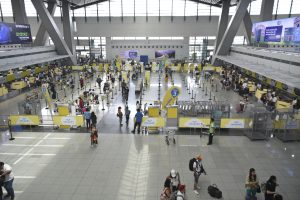The big news at the start of 2023 should have been the release of the new Philippine Development Plan and the state visit of President Ferdinand “Bongbong” Marcos, Jr. to China. But these were both eclipsed by the air navigation glitch on New Year’s Day that forced the closure of almost all of the country’s airports.
The technical glitch was traced to the malfunctioning of the power system, ironically known as an “uninterrupted power supply,” and the failure of the backup system to function on time. The ten-hour loss of power caused the shutdown of critical navigational communications, radar, radio, and the internet, not just at the premier airport in the capital Manila but in other parts of the country as well.
The result was utter chaos in airports, with 360 flights disrupted and some 65,000 passengers stranded. Opposition Senator Risa Hontiveros rightly pointed out that the human and economic cost of the New Year airport meltdown was incalculable.
At least 3,000 overseas Filipino workers were affected, which could also put their jobs in jeopardy. Most travelers were returning to work after spending the Christmas holidays in the predominantly Catholic country.
Inconvenienced passengers shared their ordeal on social media after being trapped in the airport while scrambling for food and accommodation, and struggling to rebook their connecting flights. Airlines were forced to divert flights to other countries after the country’s air space suddenly became a black hole.
Authorities said the navigation system is outdated by at least 10 to 15 years, even if it was only installed in 2018. Hontiveros wanted to probe deeper. “Dismissing it as a simple ‘bug’ ignores the systemic problems at our airports. Let us not take the easy way out and blame the equipment outright. The fact that the backup also failed could mean there are more unseen problems down the line,” she said in a statement.
The airport meltdown was the latest embarrassing news that could further degrade the status of the Ninoy Aquino International Airport (NAIA) in Manila, after years of being named as among the worst and most stressful airports in the world.
The New Year was supposed to introduce the Marcos government’s development plan for the next five years and impress the international community with ongoing reforms to stimulate the economy. Instead, domestic and global news featured the pitiful plight of stranded local and foreign tourists in Manila.
News and public attention should have been focused on Marcos’ arrival in Beijing, but Filipinos couldn’t stop talking about the airport meltdown and how the president callously posted his New Year vlog instead of addressing the unfolding crisis at NAIA.
For the riding public, the airport meltdown reflected the sorry state of the country’s transportation system. For critics of the president, it was another proof of his weak and ineffective leadership. Two days later, he flew to China, while airport operations have yet to normalize.
News about Marcos meeting Chinese leader Xi Jinping competed with the latest update in NAIA and the announcement that inflation has reached 8.1 percent, the highest since 2008.
Marcos and his team are proud of the agreements and investment pledges they got in China, including the bilateral mechanism that would deal with issues and disputes relating to the South China Sea (officially known in the Philippines as the West Philippine Sea).
Marcos is expected to enumerate the achievements of his official trip to China, but it is uncertain if this will be enough to make people forget the recent airport meltdown and the surging cost of living. The arrival speech is in NAIA, the ground zero of the airport meltdown, which could make it easier for the public to remember about how the country’s economy has failed to take off despite the confident projections and assertions of the president.
































